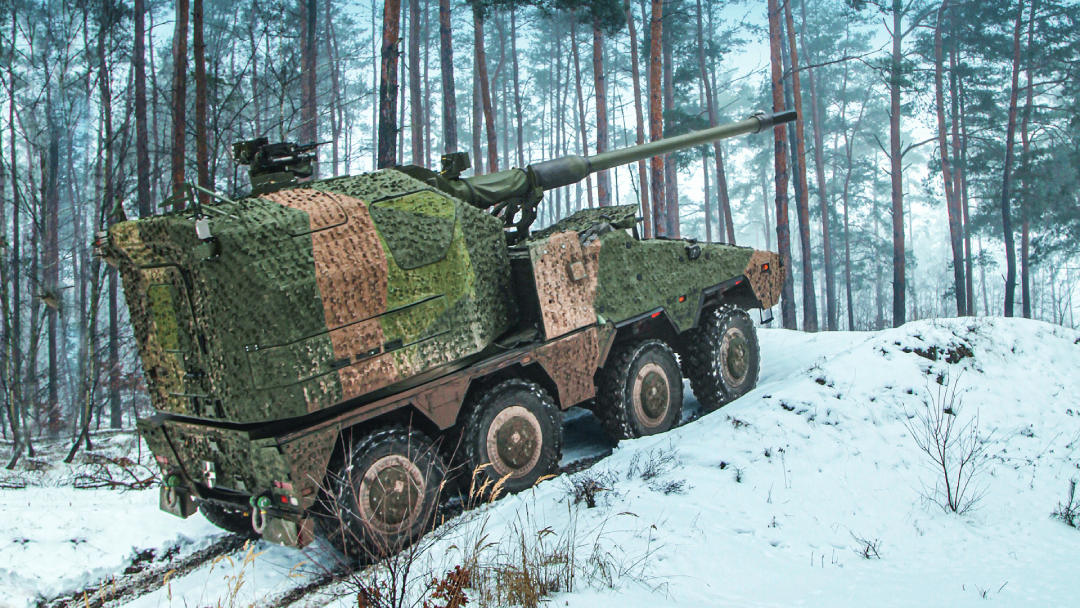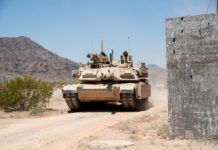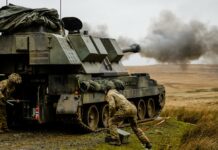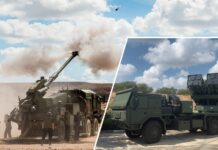Recent years have seen wheeled self-propelled artillery platforms proliferate, outpacing procurement of their tracked counterparts. Yet what challenges do designers of these platforms face, and do the claimed advantages of wheeled platforms outweigh their potential disadvantages? Yes and no.
Wheeled self-propelled artillery (SPA) is by no means a new concept, with the first examples of the type appearing while the military horse was still a common sight within all but frontlines. With regard to those early designs, it is most definitely true to say that Messrs. Heath & Robinson would have been proud of most of them, these literally being no more than assorted towed or even naval guns ‘bolted’ to the rear of a standard truck; and often not even an all-wheel drive truck, these in their infancy at that time. Basic trailing arms or stabilisers of sorts were employed for some of the bigger guns, but essentially that was it in terms of modifications.


The wheel emerges
The key to achieving ‘buzzword compliance’ for SPA is argued by some to be the adoption of a platform based or derived from a wheeled truck design, as opposed to the tracked steel box norm of the Cold War era. Adding weight to this theory, some of the simpler wheeled offerings, such as the original CAESAR 6×6 from Nexter (now KNDS France) even managed to be air-transportable in a C-130 Hercules, a feat way beyond anything comparable that is armoured, turreted and tracked. Wheeled detractors of course raise the all-important issue of tactical mobility, arguing this usurps both deployability and strategic mobility, and that a tracked solution will always have superior all-terrain mobility to any size/weight comparable wheeled peer.
However, the ‘would strategic or tactical mobility win out’ debates is one of those for which there appears to be no winner in sight. What is not debatable though is that those wheeled platforms, even the most sophisticated examples, will be cheaper to procure. Estimates of course vary, but these average out at around a 30-40% cost saving for wheels compared to tracks, and through-life costs will also favour the wheeled option. The tracked steel box option will however have the potential for a longer service life, even if that includes a mid-life refresh and/or upgrade of some form.
However, before any of the aforementioned points can become a real issue, the actual gun has to selected and mounted to a platform; and by the early 2000s the tube artillery landscape had seen considerable evolution. Naval guns were no longer a realistic option, having neither the calibre nor desired range, with their land equivalents (be that towed or self-propelled) having grown to a standard calibre (NATO) of 155 mm, and weights (towed) of anything up to 10 tonnes; and that is 10 tonnes without any enclosure for the gun, ammunition or protection for the vehicle and gun crew. A gun crew was still required at this time as full automation was essentially still an emerging technology for artillery applications.
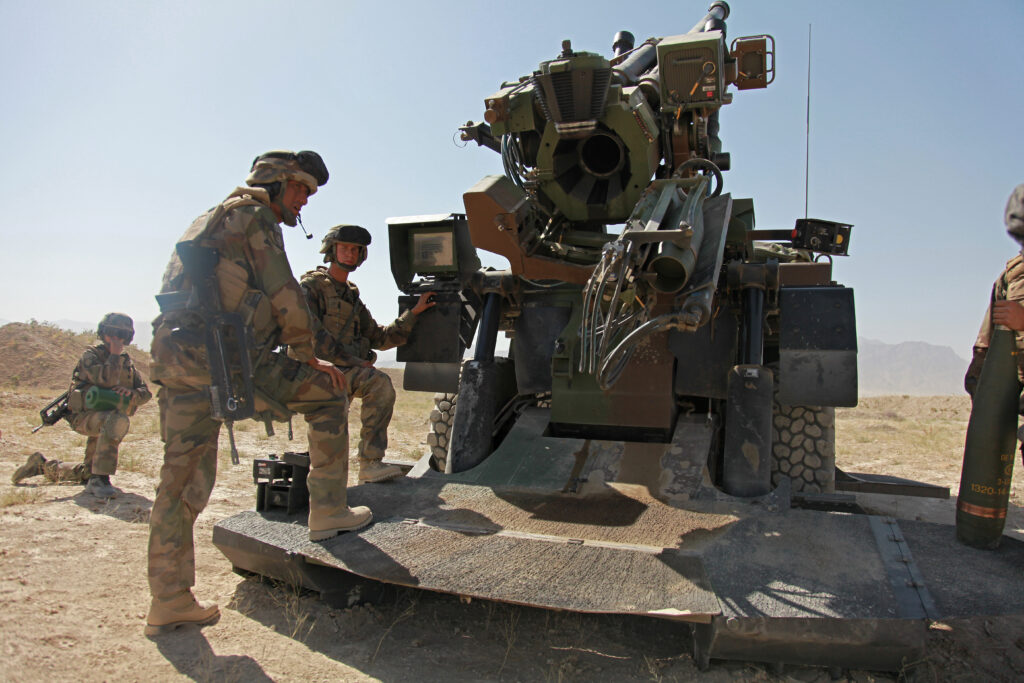
With bigger being most definitely being better, it probably goes without saying that the days of essentially bolting a gun to the body and/or chassis of a truck and ‘getting on with it’ are long gone. The technical issues in adapting even the heaviest of truck chassis to mount and handle the weights and recoil forces of a modern artillery piece without damage are no longer insignificant. However, before we look in more detail at the design challenges involved here with regard to usability, longevity and mobility, a quick look at the current and near-term SPA market will potentially explain the plethora of such designs that have emerged in the last two decades.
Projections
The statement that in terms of believability and overall accuracy, statistics rate below ‘lies and damned lies’ springs to mind when looking at the SPA market. With the usual suspects (China, North Korea, Russia etc.) excluded for the standard viable data availability reasons, a cursory projection for the tube artillery market over the next ten years suggests a potential value of EUR 50+ billion. However, in excess of 50% of that is attributable to just three countries – Poland, South Korea and the United States – and established/ordered tracked platform expenditure.
Drill further down though and over that same 10 year period, even the more conservative of estimates suggest that for to-be-placed new-build orders the wheeled market value will likely be double that of the tracked market value. With wheeled platforms cheaper than tracked platforms, this suggests that close to 75% of anticipated new-build orders could be for wheeled platforms. These new-build orders are expected to be placed for one or more of a variety of reasons that include delivering a new capability, supplementing or replacing a tracked capability, or supplementing or replacing a towed artillery capability.
As with all such projections, caution should be applied here, with many variables and caveats to be considered. In this particular instance the world’s largest defence market, the US, provides two of those. Firstly, after announcing the cancellation of the M109-based (tracked) Extended Range Cannon Artillery (ERCA) in early 2024, in its continued and urgent search for a longer ranged tube artillery solution the US Army stated following an August 2024 released solicitation that to meet this requirement both wheeled and tracked solutions will be considered. This was followed in January 2025 by an announcement that the search would commence with a Phase 1 request for proposals to be launched mid-February, with contracts to be issued around a July-September 2025 timeframe. The current suggested timeline for this effort sees initial fielding around 2030, and potentially of more than one solution. Also during 2024, US Army Futures Command head Gen. James Rainey said: “I personally believe that we have witnessed the end of the effectiveness of towed artillery: The future is not bright for towed artillery.” The US Army’s current inventory for these two types, both of which use 155 mm L39 guns, totals over 1000 pieces, 671 of those tracked (400 M109A6; 271 M109A7), with a further 850 M109A6s reported to be in storage. Ahead of the aforementioned January 2025 competition announcement, these figures will likely be bolstered by the acquisition of 689 additional M109A7s announced in early February 2025.
Additionally, it should be noted that the current spike in artillery interest has been fuelled in no small part by the war in Ukraine. In what is an artillery-heavy conflict, Ukrainian military commanders estimated that by late 2024 around 80% of casualties on both sides had been caused by artillery.
Agreement
Industry, it appears, would broadly concur with the facts, figures and projections provided in this feature, as in the last 20 or so years somewhere in the region of 30 truck-based SPA platforms have been shown by manufacturers in one form or another. That figure grows closer to 50 if China and Russia were to be included.

While some have, it is fair to say the majority of those 30 or so designs have not and/or will not make it into mass production, but even so, comparing those numbers to a figure of less than five new tracked systems appearing over that same time period and it becomes crystal clear the direction that industry believes the market is heading. If any more kudos to the wheeled argument is required, even Hanwha, the manufacturer of the market dominating K9 Thunder 155 mm tracked SPA is actively developed a wheeled K9 derivative.
However, as previously noted, to successfully design and produce a wheeled self-propelled artillery piece that capitalises on the types’ benefits whilst minimising any impact from limitations is nowhere near as simple as it once used to be.
Technical challenges
The key factors that underpin SPA performance include structural integrity and mobility, and what is interesting from a technical perspective is that these requirements often compete with one another. An early task then for any integrator or OEM has to be to determine where compromises are best made to get an appropriate level of performance.
When looking at any base chassis, alongside simple packaging and integration, the key element is structural integrity. While modern weapons have sophisticated control systems to manage recoil and movement, it is fair to say that base gun performance will be improved by having the stiffest possible platform mount. This is where things first start to get interesting.
There are limited exceptions (RMMV’s HX range being one), but the vast majority of ‘military trucks’ are based around a commercial chassis, albeit a heavier-duty ‘construction grade’ one. These with very limited exception are fitted with traditional beam-type (solid) axles, rather than independent suspension. Beam-type axles, while proven and cost-effective, offer limited wheel travel. In many cases to achieve the necessary wheel travel for reasonable levels of off-road mobility, it will be necessary to allow a degree of flex in the chassis. This flex can be in the region of up to 400 mm diagonally from corner to corner. Such flex is completely incompatible with the need to have a stiff mounting platform for the weapon and significant modifications and/or strengthening will likely be required to introduce a degree of torsional stiffness.
On a slightly more subtle note, the issue of dealing with recoil is something that will be discussed below, but in the context of the interface with the chassis, it does present a challenge. Actual recoil forces vary significantly from weapon to weapon, but at the top end, consider forces in the order of 35 tonnes, and applied in a fraction of a second. Recoil management is a key part of the weapon design, but regardless, the interface and the chassis itself need to be stiff enough to support the weapon. At the same time though, some method to provide controlled compliance will result in a much longer life. As an example, it is not uncommon to see mounts employing stacks of Belleville washers to provide a controlled stress gradient across the interface, balancing platform performance against fatigue life and durability.
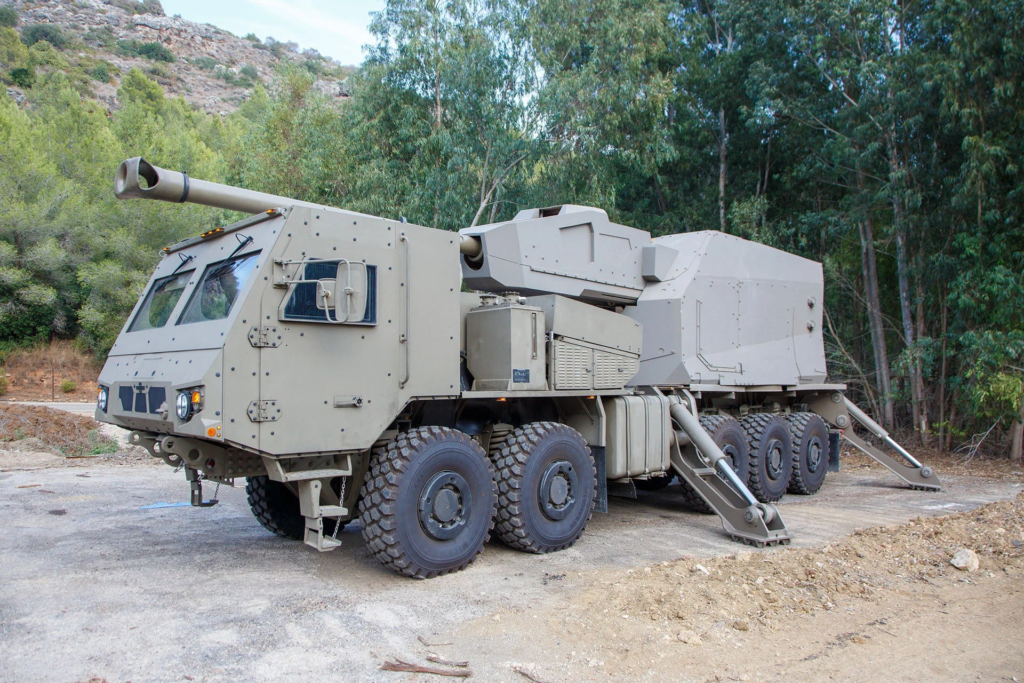
As we move down into driveline and suspension, stability and mobility become critical factors. Off-road (tactical) mobility of a wheeled platform will never be as high as that of a tracked platform, but the argument is this is generally offset by much better on-road (operational) mobility, and often easier air-transportability making for better long-distance (strategic) mobility. However, some level of off-road mobility will still be required.
Beam axle solutions, while robust and reliable, are again not your best friend here. Apart from the wheel travel limitations mentioned previously, the roll stiffness of a truck with independent suspension could be four times higher than an equivalent size vehicle with beam axles (spring spacing squared on beam axle, versus track width squared on independent suspension). This has significant implications for stability, particularly with the high centre of gravity that comes from mounting a heavy weapon high up, and operating it on uneven terrain. The addition of anti-roll (sway) bars may help control body roll, but at the expense of a further reduction in off-road mobility. While not confirmed by Oshkosh for competitive concerns, the military-specific Oshkosh platform used for Elbit’s Sigma/Roem appears to be one of very few truck-based SPA solutions to have an independent suspension set-up; the only other known independent suspension solution is offered by TATRA.
The suspension of all but the heaviest of truck chassis will likely need upgrading to manage both the increased weight and the loads from operation, but it is from the suspension onwards that the impact of recoil is most felt. For the suspension units themselves (springs/dampers/hydro-pneumatic struts) performance can certainly be improved by having some form of lock-out on the system during firing. However, the ground-platform interface, the tyres, are also a major factor. Most wheeled solutions will employ some form of outrigger to mitigate load and recoil forces. This can be either some type of spade (usually rear-mounted) that digs in to transmit recoil forces directly to the ground, or side-mounted outriggers similar to those commonly seen on mobile cranes.
In addition to reducing mechanical stress on the chassis and downwards through the suspension from recoil, the use of outriggers in particular enables firing in otherwise difficult scenarios (90° traverse, limited elevation, full charge), and they will also assist in keeping the barrel ‘fixed’ for sequential firing. The structural forces involved can make these quite substantial pieces of kit, and a further design problem for engineers is getting and spade or outrigger assembly to deploy easily and be recovered quickly, critical for survivability and the ability to conduct ‘shoot and scoot’ operations.
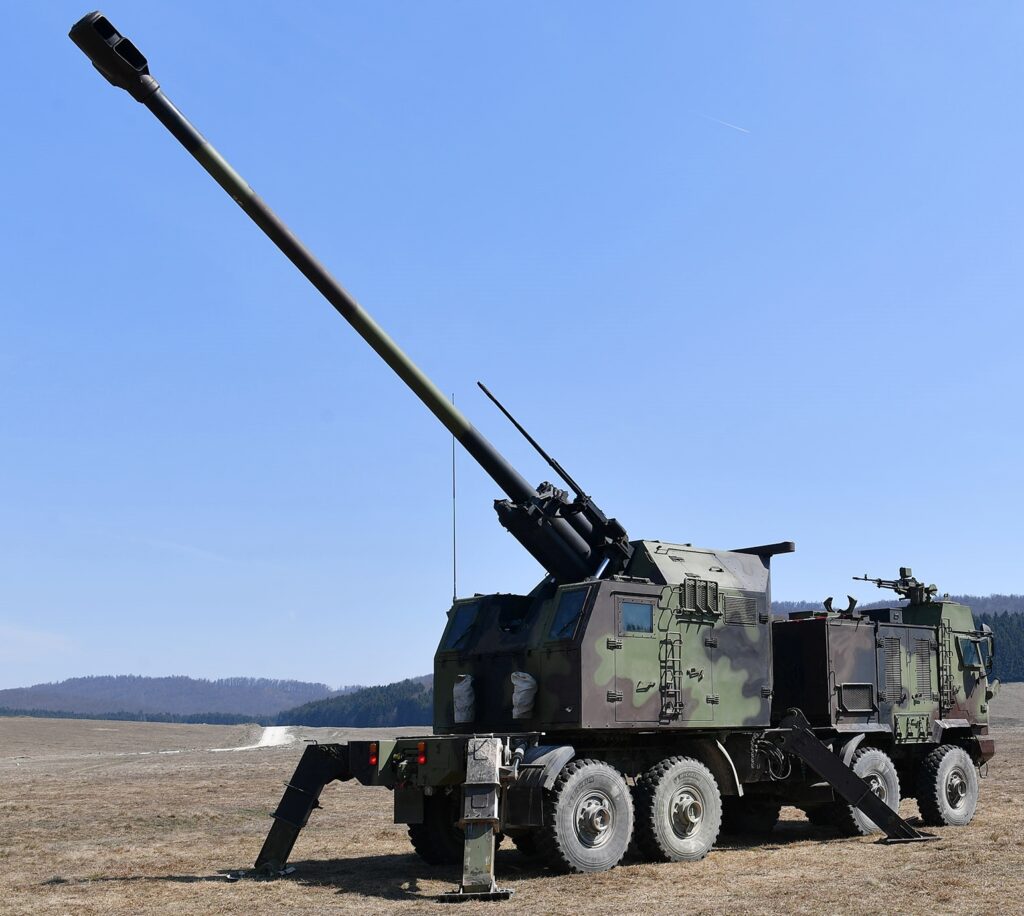

Given the battlefield role of SPA, it is likely that a level of ballistic protection (in addition to basic muzzle blast protection) will be required for the crew, this leading to the need for an armoured cab. Most of the challenges associated with the mounting of the weapon (additional weight, interface to the chassis, higher centre of gravity) will also apply to the installation of this cab. The cost and complexity of testing and certifying a protected structure such as a cab are not insignificant.
Some of the simpler SPA systems require manual loading by a gun crew that are exposed to the elements, incoming fire and similar, but the majority of higher-tier armed forces are now adopting automated systems. In this configuration having a cab and any required gun crew separate from the ordnance/turret also has the significant advantage of separating all personnel from the ammunition.

Wheeled alternatives
While a ladder- or truck-type chassis is readily-available for SPA applications and has clearly been the go-to solution for many designs, other options with wheels do exist for designers. BAE Systems’ Archer was originally offered on a modified Volvo frame-steer dump truck chassis, and while such a platform sits at the very top end of wheeled vehicle all-terrain mobility, for current Archer contracts BAE Systems has swapped to a RMMV HX truck chassis.
Elsewhere, South Africa opted to design a platform from the wheels up for its 155 mm SPA, the G6 Rhino. It should be noted however that South Africa was well ahead of the wheeled curve with the G6, design work starting in the late 1970s. Ultimately the G6 would be exported in small numbers to Oman and the UAE, both countries where the prevalent terrain types reduces the importance of the wheels vs tracks mobility argument. As an aside, it is worth noting that Iraq was quite taken with the G6 concept and from 1988 the design of two comparable platforms began, though these never came to fruition.
A further wheeled option for any SPA is that of an armoured personnel carrier (APC). Such options are relatively ‘late to the party’ and while a small number of design proposals have been muted, as of early 2025 only KNDS’ Artillery Gun Module has made it to production orders, this on ARTEC’s Boxer 8×8, along with an order on GDELS Piranha IV Heavy Mission Carrier (HMC) 10×10 platform likely to be ratified later in 2025. China’s NORINCO entered the fray in late 2024 with the SH16A, reportedly based on an VN23 8×8 base; however, there are currently no known orders for the SH16A.

Also potentially a key advantage of basing SPA on an APC platform is that with little exception these vehicles are fitted with independent suspension, have a driveline designed for 60% slopes, are not fitted with mobility-limiting lower-profile tyres, and have a central tyre inflation system (CTIS). These are all features that theoretically give a significant improvement in off-road mobility when compared to a baseline truck-type chassis. However, as always, the devil is in the detail.
For larger APCs, the most common tyre size fitted is the 16.00 R 20, which is readily available in the field. The maximum practical weight limit for reasonable soft ground off-road performance is 9 tonnes per axle, even with CTIS. Once above that weight, you also have the challenge of how to package an adequate brake unit inside a 51 cm (20 inch) rim. For tactical vehicles with hydraulic brakes, most will already have two calipers on at least the first couple of axles, but air brake units are physically bigger, so packaging two on an axle is not feasible.
This suggests 36 tonnes as being a practical limit for a four-axle platform, but looking at some options currently being offered it appears that platform weights are likely to reach or exceed 40 tonnes. Of note, NORINCO quote just 32 tonnes for the SH16A, which suggests a lower level of protection when compared to contemporary Western designs.
For a platform like Boxer, the weight issue is tackled by using tyres wider than 16.00 R 20. That is fine if you are operating your SPA alongside a comparable fleet, but if your primary fleet runs 16.00 R 20, this introduces an additional logistic burden for spare parts and maintenance, particularly in theatre.
On the driveline side, a step up from a nominal 36 to 40 tonnes obviously impacts peak torque and duty cycles, potentially requiring an upgrade, redesign, or a shorter life. It may only represent an 11% increase in tractive effort requirements, but the 60% grade climb is often a limiting factor in platform performance and the base vehicle may not have enough margin to accommodate the upgrade. A ‘simple’ modification might be to change the low ratio in a two-speed transfer case, but that assumes the housing can accommodate the different gear sizes, and you still run the risk of overloading differentials, shafts and hubs.
An alternative approach is to add an additional axle, moving from a nominal 8×8 configuration to 10×10. This is what GDELS have done with their Piranha IV HMC 10×10 base for KNDS’ AGM. This approach can preserve axle loadings, but may impact other areas, such as turning circles, requiring all wheel, or multi axle steering. With contra-steer on its two rearmost axles, GDELS’ 10×10 Piranha has a turning radius of <18 m, which is 3 m more than Boxer’s 15 m with skid steering.

The majority of platforms have a monocoque hull (without a sub-frame or chassis), this making the design of a new hull more complex, as much of the initial design integration for the driveline will need to be revisited and possibly re-designed. This has implications not just for performance and mobility, but may require additional durability testing to prove the package. Overall though, the result when using a wheeled APC-type platform is almost certain to be a solution that is narrower than any tracked equivalent (roughly 3 m versus 4.3 m), but more importantly significantly taller (roughly 3.6 m vs 2.75 m), with the associated mobility impact on centre of gravity and lateral stability.
A wheeled APC-based platform on average weighs around 20% less than a comparable tracked solution, and while benefits of this not previously covered include transport and battlefield recovery, the simpler overall box-style of most tracked platforms will, for a broadly comparable overall internal volume, offer up the ability to carry as much as 60% more ammunition.
A note on hybrid designs
Finally, this feature would not be complete without a cursory look at the unique Czech DANA and its derivatives. The DANA (Dělo Automobilní Nabíjené Automaticky; ENG: self-propelled gun loaded automatically) was designed in what is now Slovakia, and entered service in what was then Czechoslovakia in 1981. A ‘hybrid’ design, the DANA is based on a TATRA truck chassis, which is based around a torsionally-stiff backbone-type tube with swinging half-axle suspension, and suspension being fully independent on later models. Despite the chassis and suspension arrangement, the DANA also has three hydraulic stabilisers to mitigate recoil forces. The DANA has an armoured cab, and the engine compartment is located at the rear. The separate centre-mounted turret is armed with a 152 mm gun and features an early-generation automatic loading system. With the Czech Republic and Slovakia’s accession to NATO the DANA evolved to become Zuzana with a NATO-standard 155 mm gun, with the latest evolution of the concept (which is still TATRA-based) marketed as DITA.

Authors:
Shaun Connors is a truck and logistics vehicle expert. He has worked as a contributor to Janes and various other publications.
Pat Kennelly is a chartered engineer with more than 30 years’ experience. He is co-founder and director of Cytec Consulting.



